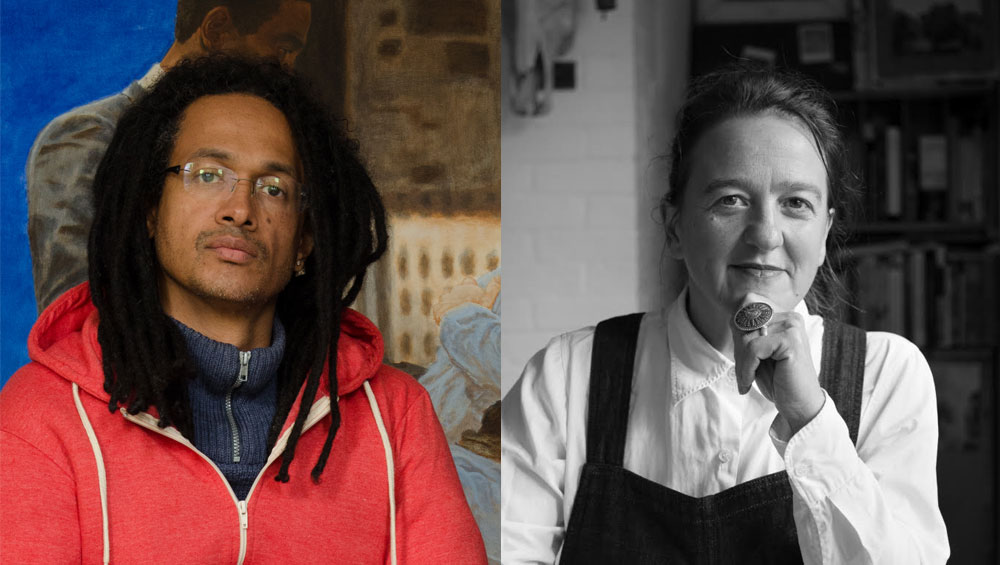
by MK PALOMAR
Tania Kovats and Kimathi Donkor are educators and practitioners. Kovats, previously head of the MA drawing course at Wimbledon College of Arts, University of the Arts London (UAL), is now professor of drawing at Bath Spa University. Kimathi Donkor has been working on the BA drawing course at Camberwell College of Arts, UAL, and has recently been appointed head of MA drawing (which is due to relocate from Wimbledon to Camberwell in 2019). To name a few of Kovats’ many achievements, as an extension of her sculptural practice she was a Henry Moore Drawing Fellow in 2004 and produced The Drawing Book, published by Black Dog, in 2005; and Drawing Water was published by the Fruitmarket Gallery in Edinburgh to accompany her solo exhibition Oceans in 2014. Her practice focuses on environmental issues and, more recently, on water as a connective element in the landscape. Her works are in many public and private collections and she has completed many commissions in the public realm. Likewise, to name just some of Donkor’s many achievements, his paintings were exhibited at the Diaspora Pavilion at last year’s Venice Biennale, he was awarded a PhD at Chelsea College of Arts, UAL, in 2016 for his research titled Africana Unmasked: Fugitive Signs of Africa in Tate’s British Collection, and his works are part of the permanent collection at the International Slavery Museum in Liverpool.
MK Palomar: Thank you, Tania Kovats and Kimathi Donkor, for having this conversation about drawing. We are here at Trinity Buoy Wharf, the new partner for the drawing prize formerly supported by the Jerwood Foundation, and have just attended a symposium on drawing, titled Lines of Thought, at which, Tania, you gave a presentation. It would seem that there is a lot of thinking, making, writing and speaking about drawing in the UK today. But I’d like to begin this conversation by throwing a small spanner into these particular works. In today’s society, in which technology and software programs govern design, photography and animation, many people are immersed in virtual environments, and our environment is chock-full of machine-manipulated images, can you tell me what is the point of teaching people the skills of drawing?
Kimathi Donkor: The best way for me to illustrate that is to reach into my pocket and take out my trusty Samsung Galaxy Note 4, which is good for these moments. When I open and unlock the Note 4, I can slip out this little pen and then, as you can see, it brings up an automatic menu. I select from the menu and it opens a program called Autodesk SketchBook, and I can just start drawing [Donkor begins sketching Kovats’ large, colourful bags]. In my view, what’s interesting about this little process I’ve just gone through – it’s not anything new, obviously: we all know that David Hockney has been exhibiting his iPad drawings for many years (I’m not really an iPad person) – but what’s interesting to me is the enormous investment, billions of dollars, that has gone into creating this device. I don’t really see a contradiction between digital electronic technology and hand-drawn objects.
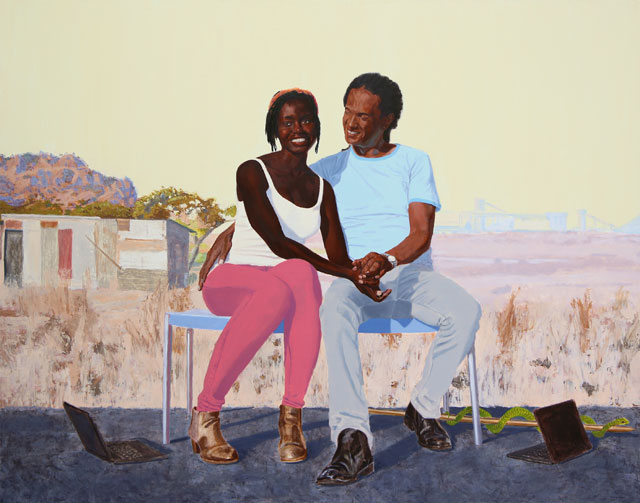
Kimathi Donkor. For Moses Had Married An Ethiopian Woman (Numbers 12-1), 2015. Oil and acrylic paints on canvas, 165 x 210 cm.
MKP: You don’t see a contradiction between the technologically drawn and the hand drawn?
KD: No, it’s the opposite. The technology companies have been investing very heavily in facilitating drawing through these kinds of devices. To me, it’s far from a contradiction – it’s more of a kind of symbiosis. And I think there are other questions that come about to do with, say, materiality. Because [he holds up his Samsung], is this a virtual drawing or is it a real drawing? I mean, it is a drawing.
MKP: Tania, what do you think?
Tania Kovats: Well, the bags you just drew are my bags and, in them, there are a couple of sketchbooks, several different pens, a paper diary, and somewhere in there is my phone. I wouldn’t use my phone to draw because I’m quite invested in the book. I’ve seen people do work on iPads, iPad Pros, reMarkables and so on that I’m really excited by. I have a curiosity about these tools, but my thinking process relates to the form of the book. I know I can find digital equivalents to a Post-it Note, but I really like the physical business of sticking a Post-it Note on a bit of paper [into a book] and scribbling on it, and marking it in that way. It’s also the sequence thing. I know you can scroll up and down – endlessly – but I like to flip backwards and forwards between my notes, things I’ve written, things I’ve drawn, and pull a drawing out at a meeting, allow other people to draw over a drawing of mine. If I’m trying to problem-solve with the drawing, I don’t mind if that drawing becomes shared. Again, I know all these things are possible on screens, but it’s a different dynamic. All we do is give ourselves different tools: we face the same problems, we want to be creative; we want to solve problems visually; we want to use drawings to make things happen. I am not that interested in setting up some kind of notional hierarchy between a drawing on a piece of paper or on a screen. I may have a preference – but it’s all about what you do with the drawing, really. Some of my issues are that our virtual worlds are not rendered well enough. I think lots of architecture that gets thrown up looks like poor digital rendering turned into buildings. But then some digital worlds surprise me – my son was playing Grand Theft Auto – which I think is a horrific game, but the drawing was amazing; the rendering of the city and the way you move through the city, demonstrated really good drawing. He is not necessarily bothered by the drawing, but I think it’s partly why the game is so compelling.
_2017.jpg)
Tania Kovats. Sea Mark (Prussian Blue IV), 2017. Watercolour on paper, framed, 100 x 150 cm (39.4 x 59.1 in). Courtesy the artist and Pippy Houldsworth Gallery, London.
KD: It’s interesting because you say he’s not that bothered, but I would say that, subliminally, the quality … and by quality, I mean …
MKP: Do you mean aesthetic quality?
KD: I mean aesthetic quality, but I also mean the tangibility of a mark – it’s really important to people, however it’s manifested. Grand Theft Auto and other games are quite photo-realistic vistas; with very Renaissance-type drawing and painting skills, which are used. But then there are other parts of the, if you like, electronic media landscape, where things are much less finished. Peppa Pig is an example [laughs] that comes to mind. So, my point is – and I agree with what Tania said – it’s not about a hierarchy, it’s more about trying to find ways in which different methods, different processes, different technologies can be a successful vehicle for expression.
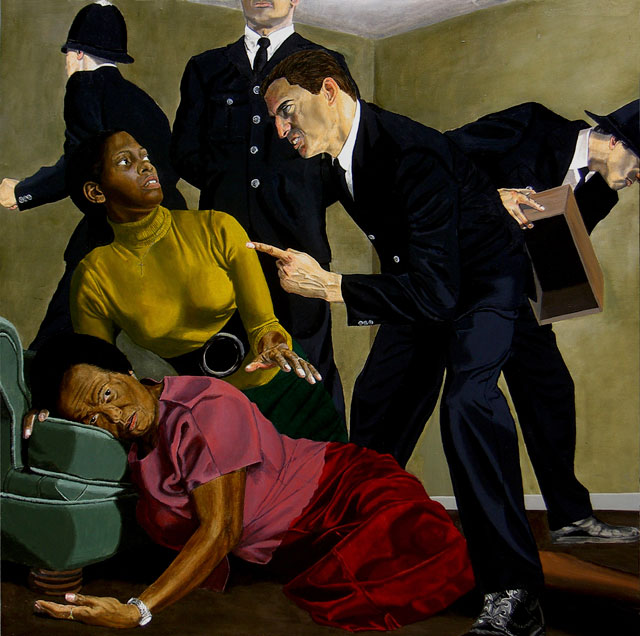
Kimathi Donkor. Madonna Metropolitan - The Death of Cynthia Jarrett, 2005. Oil on linen, 152 x 152cm. Collection of Wolverhampton Art Gallery.
TK: I think people have a concern that the digital is replacing drawing: you hear that discussed. But there’s another way, it’s also making it more essential as an experience for people because drawing decelerates experience. You slow down to draw: if you’re making an observational drawing, you slow right down to look at something and then have that hand-to-eye exchange and make a mark that tries to describe this thing. Or you slow down if you are tracking an interior viewing or trying to visualise something that isn’t real, but you’re trying to make real on the page. That kind of appetite for deceleration passes into the experience of the viewer looking at a drawing as well. You slow down to look at a drawing. Drawings are easier to find your way into, as you can literally follow a line into a drawing and around it, and then find your way out again. You can spend that time in the drawing. I think there’s something about the quality of a lot of mass-produced digital imagery, and the way we are flooded and saturated with visual material actually creates more appetite for the deceleration and simplicity that’s offered by drawing.
_72dpi.jpg)
Tania Kovats. Rivers, 2012. River water, glass, rubber, boathouse. Permanent commission, Jupiter Artland, Edinburgh. Courtesy the artist and Pippy Houldsworth Gallery, London. Photograph: Keith Hunter.
MKP: And is that deceleration an important part of teaching people drawing skills today?
TK: I think you don’t have to teach it, it just happens through the practice of drawing. If you give someone the space for drawing, if you put it in the curriculum, if you encourage it, it’s not necessary to have to make that deceleration of the content, it will just be part of the quality of that experience of drawing.
MKP: Can I go back to my first question: what is the point of teaching drawing skills, today? What are drawing skills? What is the point of them?
KD: Well, I think from my perspective, I’m glad you used the word skills – as opposed to skill – because I think that’s quite important. My first thought on that would be, I don’t think there’s just one axis on which skill can be judged or questioned and, in fact, certainly working with and teaching master’s degree students, they’re very interested in experimentation and research. They are quite interested in deconstructing what might be traditionally regarded as [for instance] Renaissance-era skills, of anatomical or geometric types of drawing. I think skill is [out of the question] and you could almost argue that skills, in the plural, are individual – they are very individualised, a person generates their own. I would perhaps put forward another suggestion – isn’t one of the goals, and the aims of the notion of art as individual expression, that people generate their own values as to what constitutes a skill?
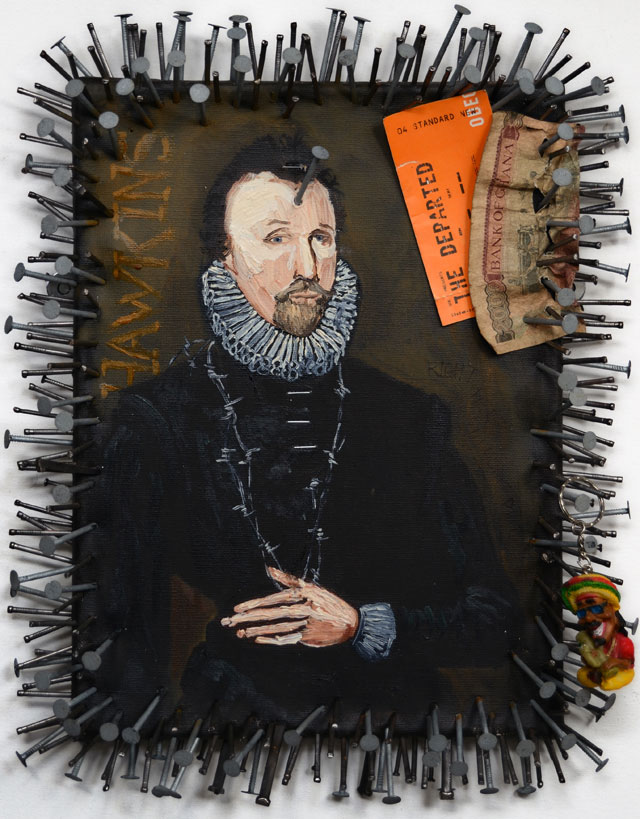
Kimathi Donkor. Arise, Sir John Hawkins, 2007. Mixed media assemblage, 230 x 142 cm. Collection of the International Slavery Museum.
MKP: And you think that applies to drawing?
KD: I think so, yes. I think it must apply. I think that’s one of the things that makes art in general, and drawing and painting and other particular areas, attractive to people, the idea that it’s a space whereby you can create your own paradigm of reality through imagination. Through an imaginative world that you create on the paper or on the surface with the mark, you’re able to determine what constitutes a skill, and what constitutes beauty, and what constitutes pleasure in looking. That doesn’t mean that I can’t transmit, as a teacher, things that I’ve learned, which might be valuable to a person. But I think, also, I come from an educational thinking point of view that does value what the student brings to the process, so I would be very hesitant to say to someone: “That’s not right.” I’d be more interested to know what it is they’re trying to achieve, and then if it’s possible that I can help them to achieve something, then fair enough. But I think we’ve moved a long way away from the notion of setting rigid parameters within which people have to work.
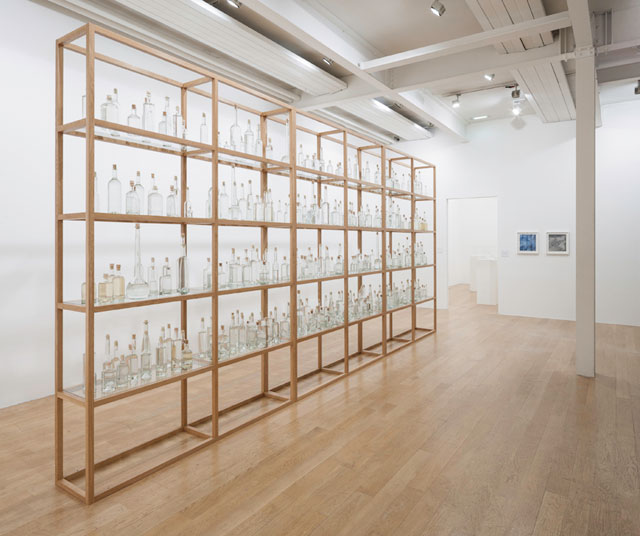
Tania Kovats. All the Sea, 2012-14. Seawater, glass, cork, oak (365 bottles), 600 x 278.5 x 40 cm (236.2 x 109.6 x 15.7 in). Installation view, Oceans, solo exhibition, The Fruitmarket Gallery, Edinburgh 2014. Courtesy the artist and Pippy Houldsworth Gallery, London. Photograph: Ruth Clark.
MKP: So, Tania can I ask you, what is the point of teaching drawing?
TK: I think it’s an essential tool of visual communication all the way through education. I totally, wholeheartedly agree with what Kimathi has just said in terms of talking about when you’re working with emerging practice in artists. How you define a good drawing is down to the kind of synergy between what an emerging artist might be trying to say, and how they’re saying it. Your job as an educator is to support them working out what they want to say, and how to say it better. “What does it mean?” is as important a question as “What skills do you need to do this?”, and “What are you communicating if you do it in this way?” No material is neutral: whether they do it in pencil, or chalk, or peanut butter, every material has an association, so it’s: “How do you make the right associations?” Now I’m just trying to think of a drawing with peanut butter …
MKP: William Pope.L, Harriet Tubman Spinning the Universe (1992).1
TK: I want to see that drawing! When it comes to working with kids in this country, the current government is squeezing creativity out of a child’s experience of learning and the curriculum. Art education is under threat in our schools. It’s a critical issue that might deprive generations of discovering the value of creative thinking. Everyone is born with the ability to draw, to make a mark. You become self-conscious about this activity when you get a bit older, when you think you are good at drawing only if you can get it to look like something, or to look like what your friend can do. There is a well-charted developmental evolution with drawing, and I think, as artists, we need to be very vocal about the importance of protecting art education in schools at all levels, and making sure it is well resourced and valued. The creative industries in this country are worth a huge amount to GDP. It’s part of the beating heart of what we do here, to be able to produce creative thinking, and that’s vital across all sorts of industries as well as creative industries, and if you start snuffing out that candle at school, where is the next generation for this? Erica Bolton2 launched a great recent campaign that has been very vocal about this in the press, and which, hopefully, will have some impact at government level. Drawing should belong to everyone, there’s no reason why it doesn’t.
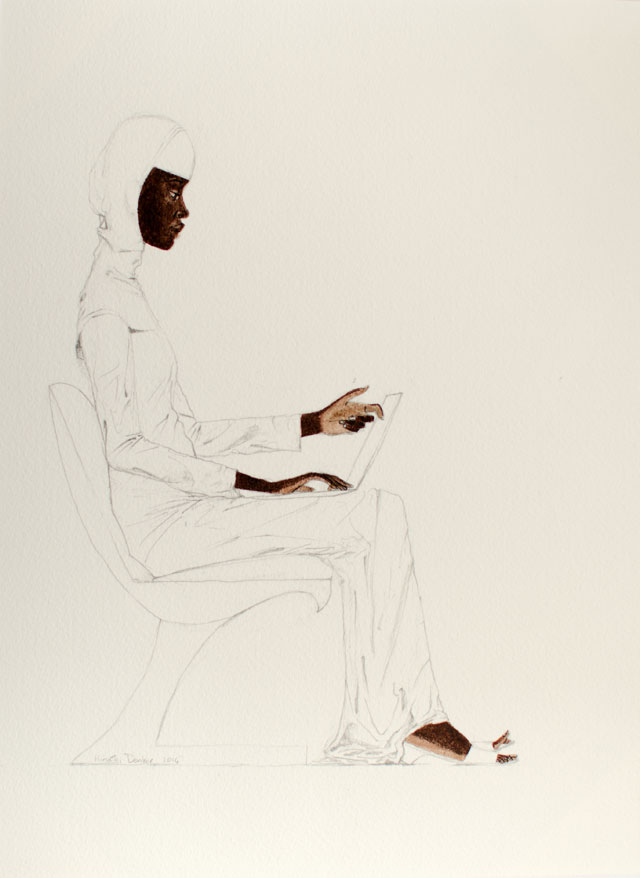
Kimathi Donkor. Notebook X, 2014. Watercolour, ink and graphite on paper, 31 x 23 cm.
MKP: How supportive are British universities now in accommodating drawing departments?
KD: That’s such a general question, which is fair enough, but I don’t feel I have enough knowledge to pontificate too much on it. What I do know is that drawing is still generally supported as an activity in art schools across the country, that is for sure. And I also know that specialised drawing courses are quite thin on the ground. There aren’t that many of them and, from my scant knowledge of the history of it, I think I’d say that it’s probably more a growth thing at the moment than a dying thing. What has happened is that most art courses, certainly at degree level, tend to be general fine art courses, and there are pathways in them, and the pathways are more likely to be around whether they are 2D or 3D as a kind of general. I don’t know if Tania agrees, that might be a gross exaggeration, but I think that’s roughly how it goes. So, I think the notion of drawing as a very specific subject taught to the highest level is still nascent. There aren’t very many master’s degree drawing courses, for example, and there aren’t very many undergraduate specialist drawing courses, but that’s also true of painting and sculpture. There’s been a tendency to have the generic fine art course, and then make different disciplines work within that. In that sense, it’s quite hard to gauge, but I do think that, if you were to look at, say, the past 20 years, there’s probably been a certain resurgence of drawing in terms of courses – for example, the rise of the course at Camberwell, and the rise of the course at the [Royal] Drawing School, these kind of things, but whether or not it will be sustained is another question.
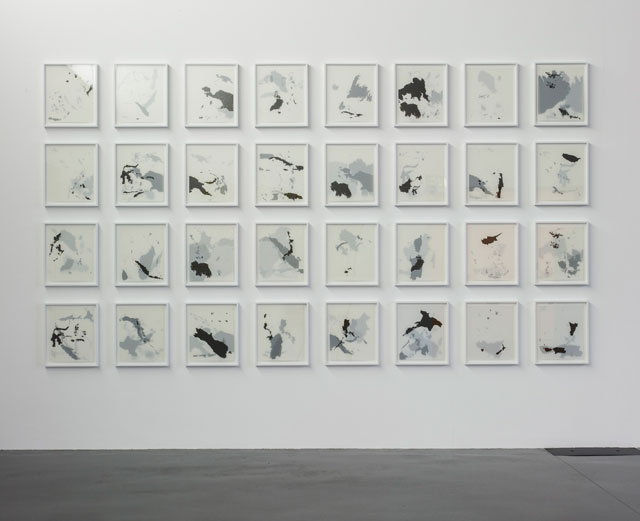
Tania Kovats. All the Islands of all the Seas, 2016. Ink on layered matte acetate, 196 drawings, 32 parts, framed, 42 x 30 cm (16.5 x 11.8 in) each. Installation view, The New Art Gallery Walsall. Courtesy the artist and Pippy Houldsworth Gallery, London.
MKP: Tania, do you have an answer to the question of how supportive universities are in accommodating drawing departments?
TK: I suppose the problem with the question might be the words “drawing department”, separating it off. I think a lot of drawing happens across fine art education and across architectural education, or design education, or visual communication or graphics. Lots of courses include drawing as completely fundamental; but there aren’t so many specialist drawing courses. There is a growing appetite for them, though – there are new courses emerging, such as the BA and MA in drawing that are starting up at Bath Spa University. However, some of the existing courses are vulnerable, as I found out at Wimbledon. Despite Wimbledon being so significant in the evolution of recent contemporary drawing practice and research, having been the home of the Centre for Drawing, and having built a community of practice around drawing at Wimbledon, the course is currently suspended. The plan is to relocate the MA in drawing to Camberwell – a college with a really strong drawing history and culture, as demonstrated by the excellent exhibition A History of Drawing, curated by Kelly Chorpening, at Camberwell at the beginning of this year. The relocation is, in some ways, a great plan, but Wimbledon has given up one of its assets by giving up on its part in the story of drawing at Wimbledon. There is a worrying direction to how art schools are being shaped at the moment, trying to streamline or consolidate them, or make them more homogenous, and rewrite their histories, to make one art school much like another – which misses the point about what’s so completely brilliant about British art schools, which is that they have particular identities and histories to offer. Art education is increasingly academicised and seen through the lens of the accountants and lawyers. The tutors try to resist this as much as they legitimately can, but it’s a challenge to deliver the sort of art education that helps nurture and form the incredible artists and creatives that offer so much to this country.
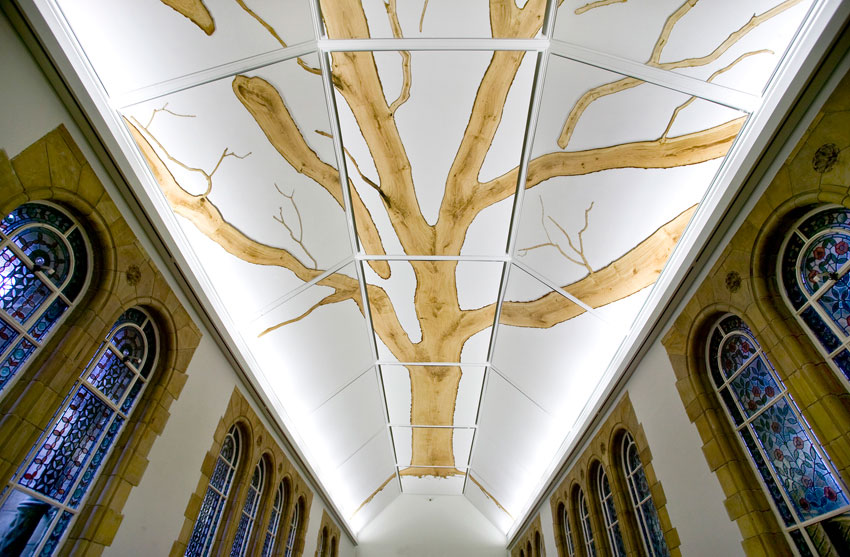
Tania Kovats. Tree, 2009. Wood, 70 m long. Installation view, Natural History Museum, London. Permanent commission. Courtesy the artist and Pippy Houldsworth Gallery, London. Copyright Natural History Museum, London.
The idea that there is a proscribed set of drawing skills that every single art student should leave art school with is something to debate; there is certainly a shift away from that. I think every student should leave with an amazing toolbox of skills, but only the skills they feel they need. It’s not straightforward; to map out what those skills have to be.
I think drawing is interesting because there’s been a very subject-specific set of research questions around contemporary drawing, dynamic conversations, and deep investigation. Part of that’s to do with the fact that it is not traditionally a primary or dominant form. Because it is sometimes viewed as a peripheral activity, or preliminary activity, on the way to something else, also allows a lot more freedom to the form. It doesn’t surprise me that it’s been adopted as part of feminist art strategy, or strategies for people who might not be mainstream in one way or another. There’s a way in which it invites activism or redefining of identity or questioning, questions about the structures of art as well. I think it’s a form that invites investigation and research challenges, partly because it’s on the sidelines. There are, of course, galleries, collectors, academic studies, awards, prizes and curators that prioritise drawing. Hierarchies have always existed in how people make art, but lots of those hierarchies get challenged – and I think drawing is good at issuing some of those challenges.
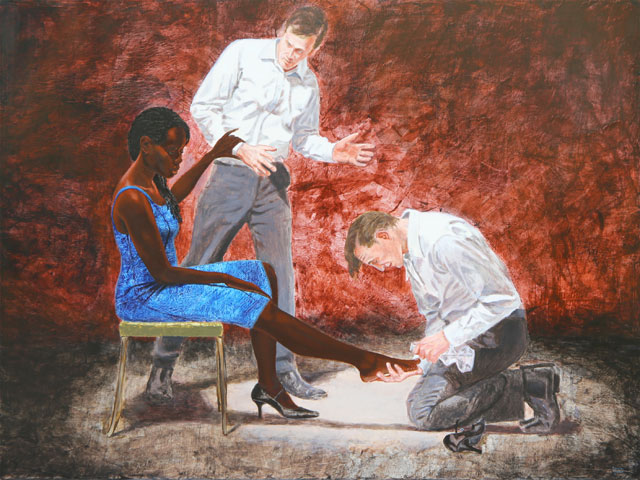
Kimathi Donkor. You Will Not Always Have Me, 2015. Oil and acrylic paints on canvas, 90 x 120cm.
MKP: One last question, please. You are both educators and practitioners, so how do you use drawing in your own practice?
KD: For myself, it has changed. It has gone through a number of transformations, and it has gone through transformations from being central – that is, the end object of what I was trying to achieve – to being preliminary or preparatory. I would never say it’s peripheral, but what I did find happening with my practice quite a few years ago was that I started to rely more and more on machines, which we were talking about at the beginning, but in a different way. I was using a lot of photography, so I would maybe start a work with a drawing sketch, then I would make photographs and then I would make paintings based on the photographs, and there would be often a kind of digital manipulation in the middle there, as well.
MKP: And would the evidence of the drawing remain in the image?
KD: In the sense that, that is how I would compose my paintings, initially through drawings. And often I would use drawing in a way which would be, say, to map out in a very raw and basic way, the general; you know in that old-school, compositional areas of a painting [manner], to say how much of the space the figure would occupy. And I would also use drawing to do things like, for example, decide the ratio of the painting, whether it was going to be portrait or landscape or square. But then, quite a few years ago, I became dissatisfied with that, partly because I felt that I was forgetting how to draw. Because I had spent so much of my time using drawing in that very immediate kind of sketchy type of way, and then spending much more time working with other forms [digital devices], that I felt I had lost the ability to really just focus and concentrate on drawings, and, by that, I mean pencil and paper drawings, for a long time. So, because I’m interested in portraiture and the body and dress, I set myself some tasks and rules that would enable me to, for example, create figures that were plausibly realistic (in terms of anatomy, proportion and perspective), but without recourse to observation or any photographic or other means, so it’s entirely working through my imagination – my memory, my hand, the pencil and the paper. So, what Tania was talking about earlier, slowing down the whole productive process and really focusing much more and very intently on the marks that I was making. At that stage, drawing started to become much more central to my practice and I started to really think about what I was doing and why.
MKP: Tania, can I ask you the same question; in what way do you use drawing in your practice? What’s it for?
TK: It’s for lots of things, actually. It’s for working something out, worrying away at a problem, moving me towards something; it moves me forward, so it takes me towards something. It also takes me inside, to things that I can’t verbalise. There’s a definite range of drawings I use that are propositional, a proposal, how to do something, and a tool of persuasion – how to bring someone with me as well. If I’m proposing a work that needs to be fabricated and commissioned and funded, drawing this thing before it exists can help to bring those stakeholders along with that vision.
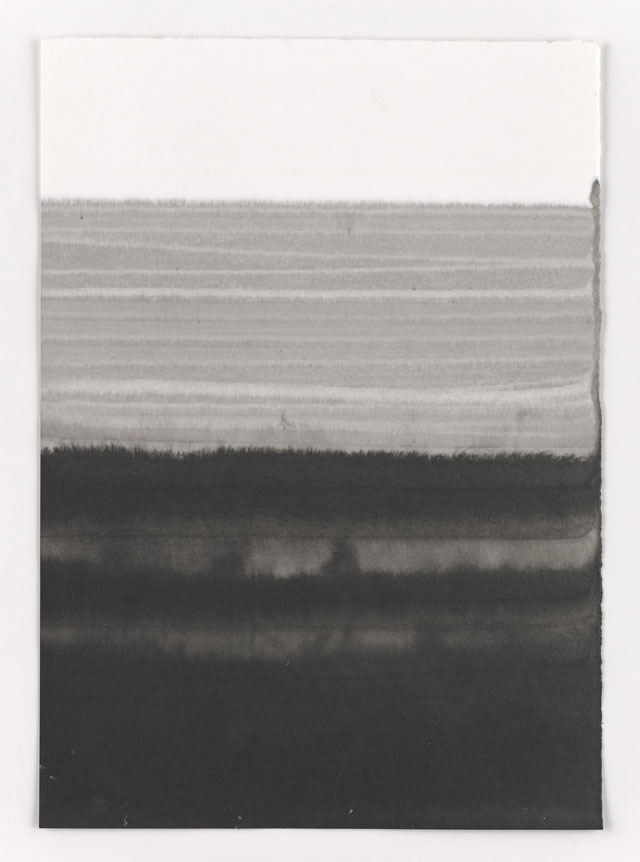
Tania Kovats. Evaporation (Black) 22, 2014. Ink, salt, water on blotting paper, framed, 42 x 30 cm (16.5 x 11.8 in). Courtesy the artist and Pippy Houldsworth Gallery, London.
I also use it as an experimental place, a laboratory. I think I make drawings, rather than draw drawings, so lots of things I do are experiments. I very rarely make a picture. It’s about allowing certain processes to take place, whether those are through mark-making, or reactions between materials, various different things. I think I use it partly as one of many meditative practices I have to stay sane. So, it’s a very quiet activity. Lots of things I do are more outward-facing, involve lots of people, whether it’s teaching or talking or producing work. I need to recover from all of that, so my drawings are also the space of recovery for me. Drawing has lots of different functions, some are private some are more outward-facing.
Drawing is also my muse; I think about other people’s drawings quite a lot, either through teaching and looking at students’ drawings, or drawings that exist in our visual culture, reflecting on the stories they tell and wanting to unravel the puzzles that they embody. The processes, subjects, narratives and meanings of drawing are my kind of muses. And not just the drawings of artists – I am completely invested in drawing as a cross-disciplinary form. It has a lot of roles for me. I think about drawings as direct acts of communication, powerful ways to engage an audience – all sorts of audiences as well, because I think it’s a very democratic form; it’s horizontal, you can invite people into the creative process through drawing, and that’s another thing of great value about it as a form.
References
1. Harriet Tubman Spinning the Universe by William Pope.L (1992), peanut butter, acrylic paint, joint compound, latex paint, charcoal crayon and news clipping. “William must have a theory about peanut butter. Its smell can initiate a Proustian episode.” William Pope.L: The Friendliest Black Artist in American, by Mark Bessire, published by MIT, 2002, pages 54-55.
2. Bolton & Quinn International Public Relations Consultancy for Arts and Culture https://www.boltonquinn.com. Artists including Tracey Emin, Grayson Perry and Wolfgang Tillmans wrote an open letter to the Guardian about the reduction in creative subjects in the new English baccalaureate that the government wants to introduce at GCSE level.